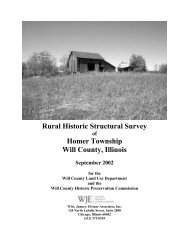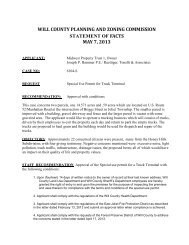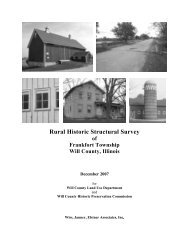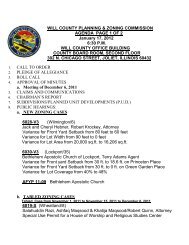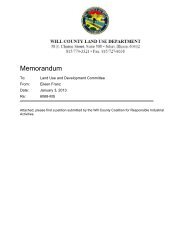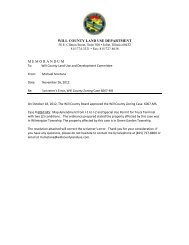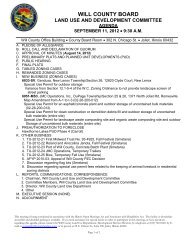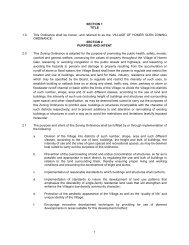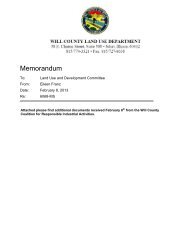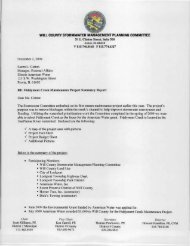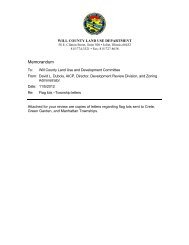Rural Historic Structural Survey - Will County Land Use
Rural Historic Structural Survey - Will County Land Use
Rural Historic Structural Survey - Will County Land Use
Create successful ePaper yourself
Turn your PDF publications into a flip-book with our unique Google optimized e-Paper software.
Wiss, Janney, Elstner Associates, Inc.<br />
River Valley lacked large platform mounds. 5 It was also a period of a widespread trading network known<br />
to modern anthropology as the Hopewell Interaction Sphere. The villages of this period were typically<br />
located on valley bottom lands, close to river transportation. Agricultural development included<br />
cultivation of floodplain lands; by 650 A.D. maize was being grown in the Illinois River valley. 6<br />
The time span between 1000 A.D. and the coming of European explorers and settlers is known as the<br />
Mississippian Period. Northeast Illinois was at the fringe of the larger Middle Mississippi culture present<br />
in central and southern Illinois. At the beginning of this period, the communities of large fortified towns<br />
and ceremonial platform mounds reached their zenith. Among these sites in northeastern Illinois is the<br />
Fisher site in <strong>Will</strong> <strong>County</strong>, located in Channahon Township.<br />
The Arrival of European Settlers<br />
Now the Lenapées had a village by the sea. They often looked out, but they saw nothing. One day something came.<br />
When it came near the land, it stopped. Then the people were afraid. They ran into the woods. The next day two Indians<br />
went quietly to look It was lying there in the water. Then something just like it [a rowboat] came out of it and walked<br />
on two legs over the water. When it came to land, two men stepped out of it. They were different from us. They made<br />
signs for the Lenapées to come out of the woods. They gave presents. Then the Lenapées gave them skin clothes.<br />
The white men went away. They came back many times. They asked the Indians for room to put a chair on the land. So<br />
it was given. But soon they began to pull the lacing out of the bottom and walk inland with it. They have not yet come to<br />
the end of the string.<br />
Wyandot tale, “The Coming of the White Man” 7<br />
French Explorers and Settlers in the Illinois Territory<br />
By the time of the French explorations of the seventeenth century, the native inhabitants of Illinois as a<br />
group belonged to the Algonquian linguistic family, closely related to the Chippewa. The specific tribes<br />
in the northeast Illinois region included the Miami (located on sites near the Calumet River, the juncture<br />
of the Des Plaines and Kankakee Rivers, and the Fox River) and the Illinois (present throughout the rest<br />
of modern-day Illinois). “Illinois” was a native word signifying “men” or “people.” 8 By the early to mid-<br />
1700s, the Potawatomi moved into the area from the region of Michigan and northern Wisconsin.<br />
Detail of a mural in the Illinois State Capitol, Springfield, showing<br />
Marquette and Jolliet on their travels.<br />
5 Several Woodland sites are present in the river valleys of the Des Plaines and Du Page Rivers. (John Doershuk,<br />
Plenemuk Mound and the Archaeology of <strong>Will</strong> <strong>County</strong>, Illinois Cultural Resource Study No. 3 (Springfield, Illinois:<br />
Illinois <strong>Historic</strong> Preservation Agency, 1988), 11–14).<br />
6 James E. Davis, Frontier Illinois (Bloomington, Indiana: Indiana University Press, 1998), 25.<br />
7 Native American Legends of the Great Lakes and Mississippi Valley, Katherine B. Judson, ed. (1914, reprinted<br />
DeKalb, Illinois: Northern Illinois University Press, 2000), 195.<br />
8 John R. Swanton, The Indian Tribes of North America (1952, Bureau of American Ethnology Bulletin Number<br />
145; reprint, Washington, D.C.: Smithsonian Institution Press, 1969), 241.<br />
<strong>Will</strong> <strong>County</strong> <strong>Rural</strong> <strong>Historic</strong> <strong>Structural</strong> <strong>Survey</strong><br />
Du Page Township Chapter I – 5



